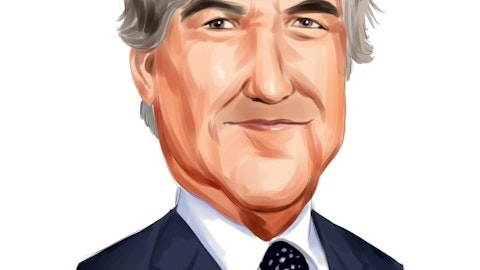Mac Schuessler: Yes. So we will. So they have a very — we spent time with the M&A team, their methodology. They’ve done a great job acquiring 24 companies over the last several years. That team will stay intact because they have very — they’re very deep into the market. They have relationships with entrepreneurs. They have relationships with companies. They have a pipeline. So we will continue to work with them to focus on Brazilian targets, and we bring capital that they didn’t have in the past, right, given our current capability and given the cash that we throw off. However, we’re not going to focus just on Brazil. Alberta is very focused on looking throughout the region, looking into other markets. So we will focus on Brazil for sure, but we’ll continue to look across the region.
Operator: And the next question comes from Nate Svensson with Deutsche Bank.
Nate Svensson : Great results. Happy to see the print. I was wondering if you could give a little more color about the contractual minimums with Getnet that you think you’re going to bust. So maybe can you talk about some of the drivers that are pushing you above that? Is this sort of growth at Getnet that has exceeded expectations? Is it efforts from EVERTEC? Is it macro? And then I guess maybe more broadly, sort of what portion of your book of business has contractual terms similar to what you have at Getnet? I know earlier you talked about Santander exceeding expectations. So I guess a little more color on what drove the Getnet performance above expectations and then how that applies to the rest of your book of business?
Mac Schuessler: Yes. So this is Mac. I’ll take sort of strategically how we think about this, and then I’ll hand it to Joaquin, if he wants to provide more details. Look, one of the things that we are proud of is that the team has — we’ve made acquisitions, we bought some good technology and then we’ve localized it in specific countries to take advantage of opportunities. But when we did that, we would match it against a real commercial opportunity. We didn’t — we don’t necessarily localize and wait for them to come, we actually localize it when there’s demand. So with some of the contracts, particularly when it was a significant build, we would put minimums in place to ensure they didn’t necessarily want to pay big implementation fees.
So we put minimums in place to ensure that we could recover our investment and not be wholly dependent on their success selling the product and that type of thing. So we have built some contracts in that manner, and this was one of the larger ones. So it’s played out very well and they have been incredibly successful. They have over 150,000 merchants up. We believe they’ve been the most successful to challenge Transbank. But not only have they been successful in that we’re recovering our investment and a good return on top, they’re blowing through it. And that’s what you’re seeing this quarter is a multi-quarter catch-up, right? So this isn’t stuff that just occurred in this quarter. We’re catching up for multiple quarters because the combination of both of our efforts have exceeded both of our expectations.
Nate Svensson : Got it. That’s super helpful color. And then another comment I wanted a little clarification on. So Joaquin, you mentioned that EBITDA margins in the fourth quarter are going to be lower to increased investments in the business and resulting in higher OpEx. So maybe you could give a little more color on what those specific investments are, what OpEx line items you’re going to see the increases and then sort of what the sort of long-term strategic rationale for those investments are?
Joaquin Castrillo: I mean I think that in this case, we’re kind of highlighting very specific projects that are coming into play. I would say, mainly in the professional lines, professional fees, pipeline and cloud services. We are continuously looking at our infrastructure, looking for ways to be more efficient to bring our technology to a next level, and just timing-wise some of those will fall into the fourth quarter. Plus we have some very specific corporate initiatives that we are doing mainly across Latin America as we continue to look at different markets and evaluate different ways of entering Brazil, et cetera, that will also fall into the fourth quarter.
Operator: The next question comes from Bob Napoli with William Blair.
Bob Napoli : I guess another question on Sinqia. Just since this is a new business for you, how do you think about Sinqia’s tech stack relative to competition? There’s a lot of innovation in the bank tech space. And I think Sinqia is doing a cloud transition to the cloud, but just any thoughts around the challenges and opportunities and how that tech stack compares to the competition.
Mac Schuessler: Yes. So Bob, what I would tell you is, look, Sinqia is acquired, like we said, 24 assets over the last decade. And then they also have a legacy business that was sort of the genesis of the company. They’ve done an incredibly good job, and we sort of interviewed the marketplace, interviewed competitors, interviewed ex employees. They did a good job providing good service, providing good technology to their customers. But they have built product road maps, and they have got to move some of the more stuff to the cloud, right? They’re in this journey. They’re not finished with it. So just like most companies that have been around for a while, they’re still migrating some stuff to the cloud. They’re still going along that journey.
And they’re still on some of their platforms, determining which one they’re going to decommission which one they’re going to keep. So they are still along that journey. But I think they’re executing it well. But that is something that we will help them focus on and make sure that they execute and that they’re able to make the migration that they’ve set out to accomplish.
Bob Napoli : And then maybe some color on the sales activity in Latin America, just the pipeline, what you’re seeing there?
Joaquin Castrillo: Bob, this is Joaquin. I mean I think as we’ve said before, the organic side of the business continues to perform very well. Obviously, is a result of some of the products and the investments that we’ve been making over time. I think Santander and what we just reported is a perfect example of how the investments that we made originally when we acquired the Chile asset then all the investments we did to convert that into a processing platform are actually now giving very good results. And that’s driving the pipeline as well. I mean this type of performance certainly brings others to take a look and participate. So we’re certainly continuing to take advantage of that.
Mac Schuessler: What’s also interesting, Bob, is as we’ve acquired these different assets and localized in different countries and then become more, I guess, of experts and how do we commercialize these and sell them. We’re beginning to find opportunities where we can bundle these products, right? So if you take 1 of our wallet solutions, you take 1 of our risk management solutions, you take 1 of our issuing solutions, can you put those together and offer unique solutions? So we feel good about the pipeline. We’re continuing to sell in the things we do business in. But now that we have a broader set of products, we’re becoming a more interesting solution to customers in these markets.
Operator: [Operator Instructions] And the next question comes from James Faucette with Morgan Stanley.
James Faucette : Just quickly following up on Sinqia. Anything that you can share in terms of key to do still to get past, whether it be from a regulatory perspective or other issues like that? Just trying to make sure that we understand what the roadmaps is here still to get that closed.
Mac Schuessler: To get — I mean, the big thing was the shareholder approval, right? So we’ve got that behind us. We’re still working through small issues, but we’re still focused on the close and feel good about getting this deal flows. But the big issue for us was the shareholder approval. That was the long pull on the top.


